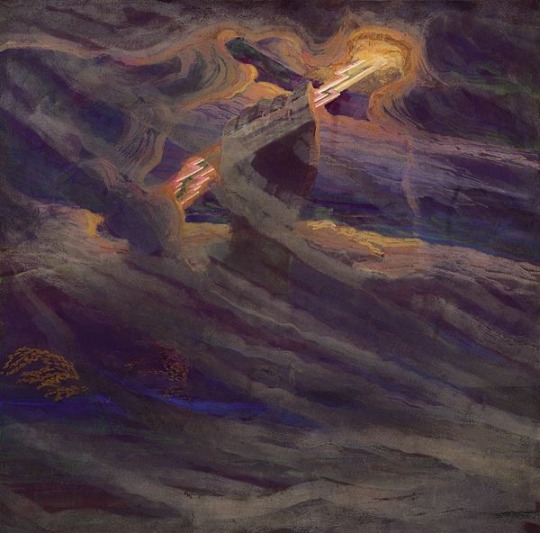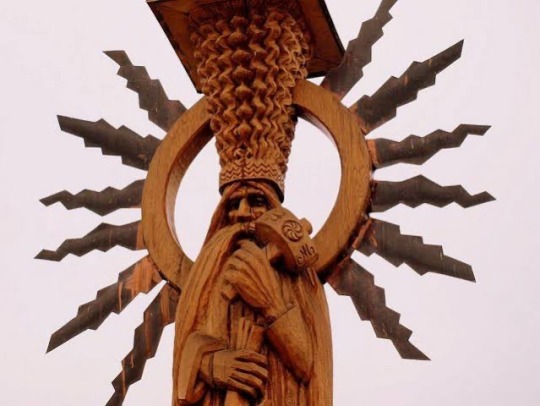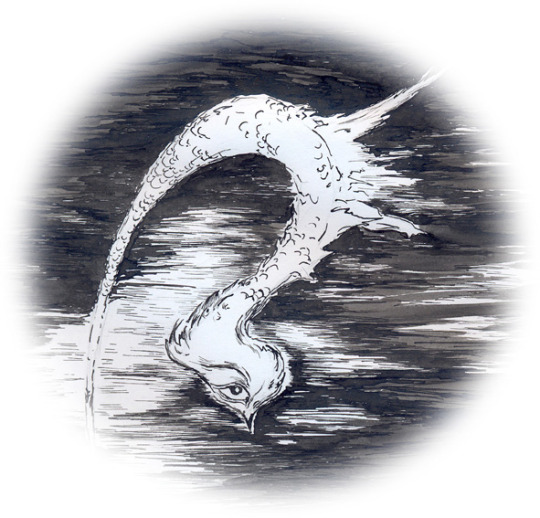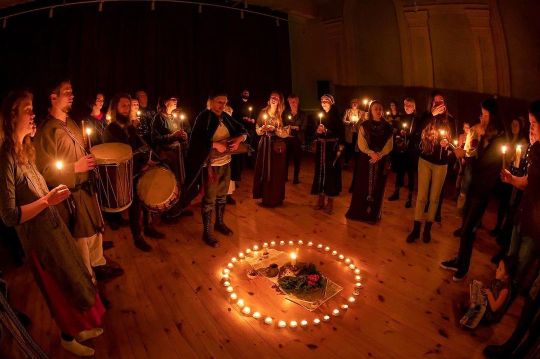#perkūnas
Text

Perkūnas
The Lithuanian god of Thunder
Attributes: lighting, storms, the sky, an axe or sledgehammer
Animals: goat
Plants: oak
Colours: black, white, grey
The sky deity of the Baltic religion, Perkūnas, is regarded as a fertility god and the guardian of law and order apart from being the god of thunder and lightning. Perkūnas is the most important Lithuanian god, and is the central figure in the Pantheon. The oak, which is the tree most frequently struck by lightning, is regarded as sacred to him.
Perkunas is usually depicted as a middle-aged man riding a two-wheeled cart with goats. In some accounts, the thunder god is seen driving a flaming horse or a cart of white and red horses through the skies. He would be identified by the constellation of Ursa Major.
On his heavenly chariot, Perkunas is holding a goat with one hand while he uses an axe or horn on the other.

Mythology
Folklore usually emphasises that Perkūnas is a patron of weather, he lives between the heaven and the earth in the clouds, he commands the thunder and lightning. Thus Perkūnas occupies the centre of the structure of the universe, becomes the master of the atmosphere (Perkūnas is correspondingly associated with the heaven and the devil - Velnias with the earth, underground, water). Perkūnas possesses a two-wheeled cart harnessed by two goats or horses , and rides through the sky , the sound of the wheels often causes thunder. Perkūnas strikes and chases the devil or devils, though often it is said that this animosity is based on personal grounds because of a certain act the devil committed (theft, insult, abduction of Vaiva, as mentioned below).

An important function of Perkūnas is to fight Velnias. He is sometimes considered the antithesis of Perkūnas and is the god of the underworld and death. Christianity considers "Velnias" akin to their "devil", though this is not in line with ancient beliefs.
Perkūnas pursues his opponent, Velnias, for picaroon or theft of fertility and cattle. Velnias hides in trees, under stones, or turns into various animals: a black cat, dog, pig, goat, lamb, pike, cow or a person to avoid Perkūnas.
Perkūnas pursues an opponent in the sky on a chariot, made from stone and fire (Lithuanian ugnies ratai). Sometimes the chariot is made from red iron.
Perkūnas possesses many weapons. They include an axe or sledgehammer, stones, a sword, lightning bolts, a bow and arrows, a club, and an iron or fiery knife. Perkūnas is the creator of the weapons (Akmeninis kalvis, "the stone smith") or he is helped by the heavenly smith Televelis (Kalvelis).
Perkūnas simultaneously is given the function of the patron of fertility, when he rolls his thunder for the first time in spring the grass starts growing, the processes of vegetation begin, Perkūnas also appears in the wedding symbolism. One other function of Perkūnas is keeping justice. He chases devils but he also punishes bad people, fights evil spirits and keeps the order of the universe.
According to ancient tradition, people who were struck by lightning were protected from devils. The objects that were struck by lightning were also used to cure various ailments, such as fever, toothache, and anxiety. Perkūnas is thus seen as a god of healing as well as destruction.
In some songs Perkūnas, on the way to the wedding of Aušrinė (dawn; the daughter of the Sun), strikes a golden oak. The oak is a tree of the thunder god in the Baltic mythology. Lithuanian Perkūno ąžuolas or Latvian Pērkona ozols ("oak of Perkūnas") is mentioned in a source dated to the first half of the 19th century.
Perkūnas is also connected to Thursday. Thursday is the day of the Thunderer in many traditions: compare Polabian Peräune-dǻn ("day of Perun"), Lithuanian Perkūno diena. Perkūnas is associated with the Roman god Jupiter in early sources. Thursday is a day of thunder-storms and rains, and also of weddings.
Family
In most myths, Perkūnas’s wife is Žemyna, the goddess of the earth. In some myths, Perkūnas would expel his wife and children and then remain in the sky by himself. The reason for this is that Perkūnas was given the responsibility of the stones in the sky whose rumbling and rubbing against each other tend to generate thunder and lightning during storms.
In songs about a "heavenly wedding" Saulė is married to Perkūnas amd cheats on Perkūnas with Mėnulis (the Moon); Perkūnas splits Mėnulis in half with a sword, which accounts for the moon phases we see today.
According to another, more popular version, Mėnulis cheats on the Sun with Aušrinė (the morning star) just after the wedding, and Perkūnas punishes him. However, he does not learn and repeats the adultery and is punished again every month. Other explanations say it is why the Sun shines during the day and the Moon at night. Though divorced, both want to see their daughter Žemyna (the Earth).
Some stories claim that Perkūnas and a woman known as Vaiva or the rainbow were supposed to get married but the bride was kidnapped by Velnias, the god of the underworld. Since then, Perkūnas has been hunting Velnias. Some stories also claim that there are four sons of Perkunas who are representative of the four seasons or the four cardinal directions. Sometimes there are seven or nine Perkūnai referred to as brothers. It is said in Lithuanian "Perkūnų yra daug" ("there are many thunders").
#Lithuanian mythology#baltic mythology#baltic paganism#perkūnas#Perkunas#thunder god#Lithuanian deities#thunder#lightning#paganism#witchblr#paganblr#mythology and folklore#mythology
29 notes
·
View notes
Photo

🔥 TRANSFORMATIONS OF PERKŪNAS • I came across an interesting article today called ‘Transformations of the Lithuanian God Perkūnas’ by NIJOLĖ LAURINKIENĖ. This paper further illustrates the subject of the relationship between PERKŪNAS and Saint George that I talked about in an earlier post about the holiday JORĖ. You can read the article here:
http://sms.zrc-sazu.si/pdf/03/SMS_03_Laurinkiene.pdf A carved wooden statue of Saint George, Lithuanian folk art. Photo by ALIAKSEI LASTOUSKI. #saintgeorge #perkūnas #spring (at Lithuania) https://www.instagram.com/p/Cdolssuvjq8/?igshid=NGJjMDIxMWI=
3 notes
·
View notes
Text
With the Curse Word Tournament ongoing, I feel like I have to tell you all a secret for veracity's sake:
'Vittu' and 'perkele' are not really Finnish words, not by their origin.
'Vittu' we stole from the Swedes: their version is 'fitta'. The meaning's the same.
And 'Perkele' -- while one of our names for Old Nick and originally probably a reference to our ancient thunder god, Ukko, in a roundabout way -- is derived from Perkūnas, the Baltic thunder god (whose other variant is Perun, the Slavic god of thunder -- it's all the same dude, really).
I mean, obviously, pretty much all words have their origin somewhere else if we want to get nitpicky about it, but... I'm sorry, our swear words are not as original as we might like to pretend. 😔
That said, 'perkele' is still the best swear word ever, no contest. And it absolutely does make it cooler that whenever you say it, you're invoking a pagan god of thunder. How many other swear words can make that claim?
#swear words#Finnish#languages#etymology#also I think it's super cool the words for lightning and thunder in Latvian and Lithuanian still refer to Perkūnas#I think 'thunder' is literally 'perkūnas' in Lithuanian#but anyway! Baltic and Slavic brothers and sisters and other siblings! Perkele is yours just as much as ours
79 notes
·
View notes
Text
Liet has an immortal dog, which ressurects in different dog bodies. His name is Lizdeika, and he speaks all the 9 languages of Baltics. Liet leaves him in charge to help his close ones when he's not able to do it himself, e.g., in concentration camps in Siberia. Rytprūsiai and Žemaitija absolutely love Lizdeika, Užupis as the youngest is still a bit scared of him.
#hetalia#i know i called him Perkūnas before but yk? i changed my mind#he's Lizdeika now#hws lithuania#aph lithuania#single dad au?#Rytprūsiai#Žemaitija#Užupis
5 notes
·
View notes
Text
HRVATSKI JEZIČNI PORTAL IS DOWN!?
#perkūnas posted smth ab linguistics and etymology so i tried to search up what word it was and#WHAT DO YOU MEAN FORBIDDEN
10 notes
·
View notes
Quote
★
Anželika Zelma Tamaš
★
http://www.satenai.lt/wp-content/uploads/2023/01/Nr.2-1402-2023-01-27.pdf
0 notes
Text
I want to make information on Lithuanian folklore in English more public so I am uploading the threads that until now were only on my Twitter. I present to you a comprehensive thread on aitvarai, the ancient Lithuanian deities of the skies


(art credits: Neringa Meškauskaitė, Agroshka )
Aitvarai (etymologically "ones to appease" or "irrepressible force") are domestic creatures associated with all 4 elements: a comet of fire which harnesses wind for chaos, helping Earth and its people while being chased and punished by Perkūnas for stealing water.
Most commonly a black rooster, they can appear as a variety of creatures: different kinds of black birds, grass snakes, whirlwinds, comets and even men if they fall in love with a woman that they want to marry.
Though very powerful ancient beings, Aitvarai choose to associate themselves with people, with villagers being able to either hatch them from an egg of a 7 year old rooster or attract them by leaving out hot, untouched meals like porridge and scrambled eggs.
When part of a household, the duties of an aitvaras were to bring riches to his caretakers, either as money (money carrying aitvarai were golden, deep red or silver in coloration) or as wheat (grey and black colors). Note that aitvarai only served the poor, tricking the wealthy people who tried to use them.
Aitvarai were both a blessing and a curse: while they did bring wealth, they did it by stealing from the neighbors of their master, making them most hated in the local village. They were also clingy and dangerous to keep, burning down the houses of those who mishandled them by feeding them manure, tampering with their meals or disobeying the rules they set for the person.
It is said however that their thieving, evil nature was a characteristic given to them by the Catholic church, which wanted to demonize every pagan creature in Baltic mythology.
In fact, aitvarai were considered genuine problems by those who believed that they would steal from them: from warding off statuettes in granaries to court cases from 1700's accusing people of harboring an aitvaras (I found only one source claiming this, so take it with a grain of salt).
However, the desire to have an aitvaras was apparent as well, shown by modifications peasants would make to their homes: holes in the doors of granaries would be made so an aitvaras could enter the home easily.
Some rituals for stealing back from a flying aitvaras exist as well, ranging from simply showing it your bottom, to cutting oneself with a rusty knife, pinning the corner of your jacket to the ground, ripping or otherwise ruining clothing.
Even if the reaction of people to them was mixed, aitvarai were considered pests by the gods due to their tendency to drink/hoard water, for which they were struck dead by Perkūnas, exploding into sparks that caused forest fires, the thunder god's lightning forming ponds, holes and swamps, terraforming the earth.
#lithuania#mythology#folklore#lithuanian folklore#lithuanian mythology#aitvaras#aitvarai#eastern europe#Viltės threads
163 notes
·
View notes
Text
A tentative proposal for a Slavic trifunctional triad.
(Key: Polabian — Russian — Baltic — Norse)
First function: Svątevit — Veles — Velnias — Óðinn
Second function: Ruyevit — Perun — Perkūnas — Þórr
Third function: Yarovit — Dažbog — Petrimpo — Freyr
8 notes
·
View notes
Text

Lithuania : Birute Hill near Palanga, Lithuania, was once home to paleo astronomical observatories. Restored in 1998, the Samogitian Sanctuary is a recreation of a Pagan observatory from the Middle Ages. This northern Lithuanian group of statues is based on artifacts found at the site of a prehistoric astronomical observatory and shrine that stood til the 16th century.
During the key calendar holidays, Lithuanian people would carve wooden poles that correlate to the Balts' gods and goddesses. These Gods and Goddesses are Perkūnas, Aušrinė, Žemyna, Austėja, Ondenis, Patrimpas, Patulas, Velnias, Leda, Saulė and Mėnulis.
#Lithuania#ancestors alive!#what is remembered lives#memory & spirit of place#ancient ways#sacred ways#folkways#traditions#paleo astronomical observatories#Samogitian Sanctuary#Gods#Goddesses
6 notes
·
View notes
Note
science and Looking :)
YEAAHHH HEY PERKŪNAS ♡♡♡♡
3 notes
·
View notes
Note
okay okay you got me i'll bite what is martin syrett's etymology of óðinn and how does the new finding support it. if you wanna.
So I gotta warn you this is kind of really niche and after taking a closer look I'm not actually sure the bracteate is evidence of this after all. I'm gonna try to hit the most important points but I'm skipping over lots of details.
In standard notation for transliterating Scandinavian runic inscriptions, you use square brackets [ ] to fill in runes that can be inferred but not directly read, usually by damage. Krister Vasshus has been transliterating this wod[i]nas, but in retrospect we might have to wait for their full paper to know how confident he is in that [i]. Here's the wod[i]nas, cropped and mirrored:

There is room for an i rune (and importantly, not for an a rune) but I'm not sure if Vasshus thinks it was actually there and got damaged or if the maker just left it out (which happens). I left that comment in the notes on the assumption that it was there originally. I can see a faint ᛁ-shaped darkness where it should be but I also admit that I really, really want to see it and that's not a great situation and I should be waiting for Vasshus to go into more detail.
Anyway, people are probably familiar with the idea that Óðinn's name was, at an earlier level of development of the language, *Wōdanaz. This is based on forms like OE Wōden and OHG Wuodan, but not on Óðinn, because there are some phonological problems. If *Wōdanaz had passed down into Norse unmodified, it would be *Óðann (supposedly attested in OSw. ōþansdagher 'Wednesday'). If, on the other hand, it had been *Wōdinaz, that would trigger umlaut, and the Norse would be *Ǿðinn (also supposedly attested in OSw. ǿþinsdagher).
Óðinn has long been recognized as an example of a word composed by means of what's called the Herrshersuffix (roughly 'ruler-suffix'; the term is usually attributed to Wolfgang Meid who wrote a detailed essay on it in the 30's but I'm not sure he actually used the term and actually went to great lengths to avoid giving it that precise a meaning). It's found in a lot of Indo-European languages and works something like this: to make a name of a ruler, representative, or possessor or some word, take that base word's stem, lengthen the stem vowel, add *-n-, and add the masculine or feminine a-stem ending. To get a Lithuanian god of oaks, you take a word for oak (PIE *perkus), lengthen the vowel: *perkū- and add *n-as: Perkūnas. This is a brutally oversimplified version. Germanic and Celtic normally skip the vowel-lengthening step (what that really means is they kept making new ones after some Indo-European phonological features were lost).
Other examples in Germanic languages include *druhtinaz 'lord' (ON dróttinn, OE dryhten) from *druhtiz 'troop'; ON þjóðann 'ruler' from þjóð 'people, nation'; ON Herjann (a name of Óðinn, but literally 'army-leader') from herr 'army'; and others.
Meanwhile, there is pretty much the same problem with all of the preterite participles in Old Norse. The participle ending is -inn, and already was in the Elder Futhark period (faikinaʀ, haitinaʀ, slaginaʀ all attested) but does not cause umlaut (which it "should" according to everything else we know about the phonological development of Norse); and the Proto-Germanic reconstructed participle ending is *-anaz. Despite the ending -inn, many of those words even show signs of having had an *a there in the past (can explain on request).
Trying to resolve this has been kind of an ongoing argument for like a hundred years, it's not especially consequential but it's one of those things where it's weird that it hasn't been put to rest.
Syrett's proposed solution was that the participle ending was completely replaced, and the Herrschersuffix partially, by a similar but different suffix that also already existed in the language. Words like gullinn 'golden' and eikinn 'oaken' are formed with a suffix reconstructed *-īnaz and which belongs to a class of suffixes that behave a little bit more like words in compound words, meaning a different set of phonological rules applies. The word gullinn doesn't have umlaut in Old West Norse (would be *gyllinn; this works differently and unevenly in East Norse, e.g. Danish gylden, but it's also in Old Swedish that *Œðinn is supposedly found alongside *Óðann).
Meanwhile, the word wodinʀ is already attested on the inscription Sö Fv2011;307 but it's highly lacking in context and a lot of people have not counted it as a pre-Norse attestation of Óðinn, or at least not as a secure one, though it is exactly what would be predicted by Syrett's theory. Even if it is accepted, the new find is significantly older, so the new one is still important.
I'm invested in all of this because it's kind of implicated in a load-bearing pillar of my MA thesis.
9 notes
·
View notes
Note
Hello I have a question relating to Peruns name. Recently I saw a drawing that was a sort of amalgamation of Indo European thunder gods. The drawing had a bunch of names labeling which part of the drawing represented which thunder god. Among them was Perkwunos, Perkunas, and of course Perun. Could you help me understand this a bit more ? Thanks!
I can’t say with certainty which drawing you meant so I am going to assume you mean this one. As you correctly noticed the figure pictured is an amalgamation of various thunder deities with attributes of some of them:
Proto-Indo-European Perkwunos (with a crown, I suppose because he’s viewed as a prototype for many western indo-european thunder deities?);
Norse Thor, with his preferred weapon the hammer;
Celtic Taranis with the chariot wheel;
Baltic Perkūnas (alternatively Pērkons, Perkunos etc.) (no attribute?);
Slavic Perun with what is commonly viewed as his preferred weapon, the axe;
Hindu Indra with his ritual weapon vajra.
Of course all the gods named here are very much separate and they have their own unique cult, myths and traits. While they may share certain qualities and the narratives in which they play central role may be similar (to varying degrees) it would be a mistake to view them as the same and an oversimplification to call them „X’s version of Y” (example „Perun is the Slavic version of Thor”).
I am not certain what it is that you’d like to know about Perun’s name. We don’t know for sure if all tribes that worshipped Perun called him that, but since Perun is the name we do know this is what is generally used. Slavists made some attempts to connect Perun to polabian Prove/Prone and Porentius but it’s really hard to tell if they were really the same deity adressed by a slightly different name or wholly different gods of similar type.
In his „Mitologia Słowian” Aleksander Gieysztor explains that Perun’s name should be understood as „The Striker” (or „The One Who Strikes”), from the core „per” („to strike”) and suffix „-un” (which makes the word an agent noun). The secularization of his name is most likely how Polish word „piorun” (meaning the electrostatic discharge accompanied by lightning and thunder, often used synonymously with „błyskawica”, the lightning) came to be made.
10 notes
·
View notes
Photo

Romuvos Perkūno dienos apeigos Vilniuje • Romuva Perkūnas Day rite, Vilnius. Photo by Vytautas Daraškevičius. #perkūnas #romuva (at Vilnius, Lithuania) https://www.instagram.com/p/CoOGamTPKFt/?igshid=NGJjMDIxMWI=
0 notes
Text
Theory: The name "Sabazios"
The Phrygians were a nation that interacted with the ancient Greeks from at least the 7th century BCE. Being an Indo-European group, their mythology matches Greek and Roman pantheons almost one-for-one. A notable example is Sabazius (Σαβάζιος), their paternal sky-god associated with horses and lightning.

Sabazius was considered by some to be the son of Kubeleya (Cybele)
The name Sabazius has an uncertain etymology. It's assumedly a Hellenized form of a Phrygian name, but knowledge of the Phrygian language is limited due to its scarce attestation. I have a theory of where the name may come from based on sound changes and comparative mythology.
Firstly, the symbols associated with Sabazius (clouds, horses, thunder, the heavens) link him with various other Indo-European chief gods (Perkūnas, Deipatura, Dyaush, etc.) so his name may stem from a common Proto-Indo-European term for "deity." Usually the chief god of an Indo-European pantheon has no personal name, but is instead referred to with a title and an honorific (e.g. "Sky Father", "All Father", "King of the Gods") and "Sabazius" may be no different.
The element Ζιος seems to come from an earlier Ziwos (Ζιϝος), which ultimately stems from Proto-Indo-European "Deywós" ("God", "Divine Being"), the root of names like "Zeus" and "Iūpiter." So without much resistance we could assume a part of Sabazius' name means "-god."
"Saba" is the challenging bit. It may stem from a native Phrygian word, but when written in the Greek alphabet its original form might have been obscured (older texts render it as "Σεβα"). It may be related to the verb "σέβομαι" ("to be in awe/admiration"), making Saba-Zios' name "The Venerable God" (fitting the deity's role), the usual scholarly conclusion.
I personally think the "saba" element may be related to the Semitic element "ṣaba" ("army"), hence "God of Armies", as Sabazius was associated with Dionysus (see Aristophanes' The Wasps) and Dionysus had an army of devoted maenads. But I guess the beauty of Greek myths is that we may never have the full set-in-stone picture, allowing for the mythology to be truly alive for each new generation.
3 notes
·
View notes
Text
"Kill 'em with kindness." WRONG!! CURSE OF PERKŪNAS!!‡☩✥✣❇✥☩‡✣❇✥☩‡✣❇☩‡❇✣☩‡✥☩‡✣❇☩‡☩✥✣❇☩‡✥✣❇‡☩✥✣❇‡☩✥✣❇‡☩✥✣❇‡☩✥✣❇‡☩✥✣❇‡☩✥✣❇‡☩✥✣❇‡☩✥✣❇‡☩✥❇✣‡☩✣❇✥☩‡✣❇☩✥✥✣‡☩❇✥✣‡☩❇✥✣‡☩❇✣✥‡☩✣✥‡✥❇☩‡✣✥‡☩❇✥✣‡☩✣❇✣✥‡☩❇✣❇✣☩‡
#shitpost#Lithuania#Latvia#Belarus#baltic#there are no symbols of Lithuanian pagan crosses to copypaste what a shame#okay Ukraine technically too
16 notes
·
View notes
Text
Sometimes a stranger tags my post with a hetalia character and i want to be offended but it very much feels like a "girl what were YOU doing at the devil's sacrament?" moment like maybe if i wanted to deserve to be offended i shouldn't have recognised the name
#perkūnas is the only one allowed to tag that post with tolvydas.#nobody else!! and for me that's a mikacore post bc he seems like the type and i'm a slavic woman who wants to murder him with an axe
10 notes
·
View notes